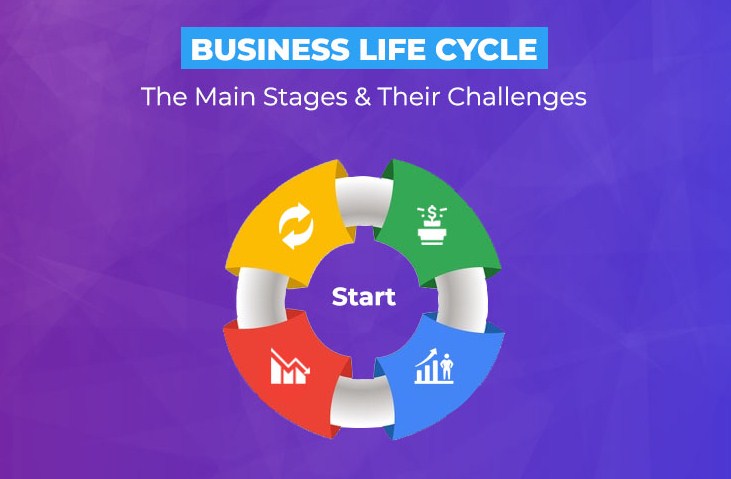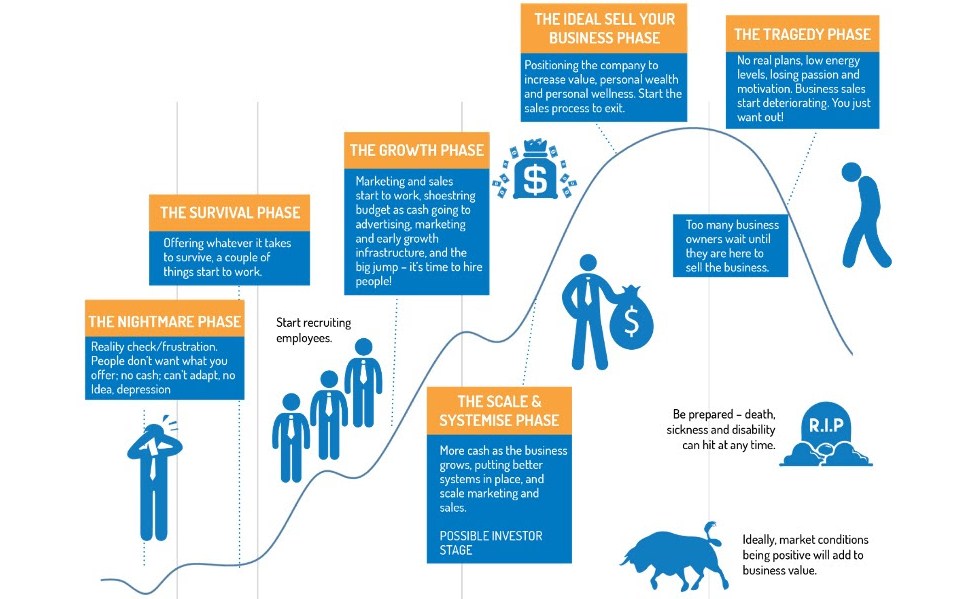Stages of the Business Life Cycle – Starting and growing a business is an exciting yet complex journey. Every business, no matter how big or small, goes through a specific sequence of stages. This journey is often referred to as the “business life cycle.” Understanding the 7 stages of the business life cycle in order can help entrepreneurs and business owners anticipate challenges and seize opportunities for growth.

In this article, we’ll explore the 7 stages of the business life cycle, give real-world examples, and highlight products and tools that can help you at each stage. By understanding the life cycle and choosing the right tools, you can build a sustainable and profitable business!
What Are the 7 Stages of the Business Life Cycle?
The 7 stages of the business life cycle represent the phases through which a business goes as it grows and evolves. Each stage presents unique opportunities and challenges that require careful attention. Here’s a breakdown of the 7 stages:
1. Seed Stage (Idea)
- Description: This is the beginning phase, where the entrepreneur has a business idea but has not yet launched. It’s characterized by market research, idea validation, and planning.
- Key Focus: Business validation and setting a clear vision for your product or service.
Example: A software developer creates an innovative mobile app idea to help remote workers track their productivity.
2. Startup Stage
- Description: This is when the business is officially formed and operations begin. Entrepreneurs begin securing customers, developing their product, and facing challenges like financing and marketing.
- Key Focus: Product development, marketing, and initial customer acquisition.
Example: The mobile app in the previous example launches its beta version to test the market.
3. Growth Stage
- Description: This stage is all about scaling the business. The product or service is validated, and customers are showing strong demand. Businesses in the growth stage often secure funding to scale operations.
- Key Focus: Expansion of product offerings, team growth, and securing more customers.
Example: The mobile app expands its features, hires a team for marketing, and focuses on user acquisition.
4. Maturity Stage
- Description: At this stage, the business has established itself in the market, with consistent revenue and a loyal customer base. The focus shifts to efficiency, optimizing operations, and managing cash flow.
- Key Focus: Optimization of processes, maintaining customer loyalty, and exploring new markets.
Example: The app now has millions of active users and is making revenue through subscriptions and ads.
5. Expansion Stage
- Description: This is when the business looks to expand into new markets or diversify its offerings. It’s a growth period but often requires new strategies and investments.
- Key Focus: Geographical expansion, new product lines, and strategic partnerships.
Example: The mobile app begins to offer its services in multiple languages and markets.
6. Renewal or Decline Stage
- Description: Every business faces a turning point. During this phase, the business must either renew its model to stay relevant or face decline.
- Key Focus: Revamping the business strategy, improving products, or pivoting to new areas.
Example: The app faces competition from newer apps, requiring it to innovate or improve its features to maintain its user base.
7. Exit Stage
- Description: The exit stage is when the business is either sold, merged, or closed. Entrepreneurs may look for an exit strategy once the business is at its peak, and they are ready to move on.
- Key Focus: Selling the business, merging with another company, or shutting down.
Example: The app is acquired by a larger tech company that sees value in its user base and technology.
Key Benefits of Understanding the 7 Stages
By understanding the stages of the business life cycle, entrepreneurs can:

- Anticipate Challenges: Foreseeing what challenges each stage presents enables better preparation.
- Strategize Growth: Identifying the right strategies for each phase helps you grow without missing key opportunities.
- Avoid Pitfalls: Understanding the natural progression of business can help you avoid costly mistakes.
- Optimize Resources: Align your resources with the needs of each stage, leading to better efficiency.
Essential Tools for Each Stage of the Business Life Cycle
Let’s take a closer look at 5 products/tools that can help your business thrive in each of the 7 stages of its life cycle.
1. Seed Stage: Idea Validation Tools
Tool: SurveyMonkey
- Use Case: SurveyMonkey is a great tool for conducting market research and gathering feedback on your business idea.
- Pros: Easy to use, customizable surveys, and vast analytics.
- Cons: Limited free plan.
- Price: Starts at $25/month.
- Features: Customizable surveys, analytics dashboard, integrations with other tools.
| Feature | SurveyMonkey | Other Tools |
|---|---|---|
| Custom Surveys | ✅ | ❌ |
| Analytics | ✅ | ✅ |
| Integrations | ✅ | ❌ |
2. Startup Stage: Business Planning Tools
Tool: LivePlan
- Use Case: LivePlan helps you write a business plan, forecast financials, and track progress.
- Pros: Intuitive interface, excellent for beginners, and good financial planning features.
- Cons: Relatively expensive for small businesses.
- Price: $20/month.
- Features: Business plan creation, financial forecasting, collaboration features.
| Feature | LivePlan | Other Tools |
|---|---|---|
| Business Planning | ✅ | ❌ |
| Financial Tracking | ✅ | ✅ |
| Collaboration | ✅ | ❌ |
3. Growth Stage: Customer Relationship Management (CRM) Tools
Tool: HubSpot CRM
- Use Case: HubSpot CRM is perfect for businesses looking to manage leads and customers as they scale.
- Pros: Free tier available, easy to use, excellent reporting tools.
- Cons: Limited features in the free version.
- Price: Free, with paid plans starting at $45/month.
- Features: Contact management, email tracking, lead generation.
| Feature | HubSpot CRM | Salesforce |
|---|---|---|
| Contact Management | ✅ | ✅ |
| Lead Generation | ✅ | ✅ |
| Reporting | ✅ | ✅ |
4. Maturity Stage: Financial Management Tools
Tool: QuickBooks
- Use Case: QuickBooks is ideal for businesses in the maturity stage to streamline accounting, invoicing, and payroll.
- Pros: Scalable, integrates well with other tools, reliable support.
- Cons: Learning curve for beginners.
- Price: $25/month for the Simple Start version.
- Features: Payroll processing, expense tracking, reporting.
| Feature | QuickBooks | FreshBooks |
|---|---|---|
| Payroll | ✅ | ❌ |
| Expense Tracking | ✅ | ✅ |
| Reporting | ✅ | ✅ |
5. Renewal Stage: Innovation and Market Research Tools
Tool: SEMrush
- Use Case: SEMrush is a competitive research tool that helps businesses stay ahead of the competition by analyzing market trends and keyword performance.
- Pros: Excellent for SEO, keyword research, and competitor analysis.
- Cons: Expensive for startups.
- Price: Starts at $119.95/month.
- Features: Keyword research, market trends, site audit.
| Feature | SEMrush | Ahrefs |
|---|---|---|
| Keyword Research | ✅ | ✅ |
| Competitor Analysis | ✅ | ✅ |
| Market Trends | ✅ | ❌ |
Where to Buy These Tools
You can easily purchase or subscribe to these tools online through their official websites or through their respective marketplaces. Here are direct links to buy each tool:
- SurveyMonkey – Start Your Market Research Today!
- LivePlan – Plan Your Business with Ease!
- HubSpot CRM – Manage Your Customer Relationships
- QuickBooks – Streamline Your Finances
- SEMrush – Stay Ahead of the Competition
5 FAQs About the 7 Stages of the Business Life Cycle
- What are the 7 stages of the business life cycle?
- The 7 stages are: Seed Stage, Startup Stage, Growth Stage, Maturity Stage, Expansion Stage, Renewal/Decline Stage, and Exit Stage.
- Why is understanding the business life cycle important?
- Understanding the business life cycle allows entrepreneurs to anticipate challenges, plan for growth, and make informed decisions at every stage.
- How can I accelerate my business’s growth?
- By focusing on scaling your operations, using the right tools, and constantly innovating your offerings, you can accelerate growth during the Growth and Expansion stages.
- When should I think about selling my business?
- The Exit Stage comes when your business has achieved maturity, but you feel it’s time to move on, either through selling, merging, or closing.
- What are the key tools to use during the business life cycle?
- Tools for each stage include SurveyMonkey for validation, LivePlan for planning, HubSpot CRM for customer management, QuickBooks for financials, and SEMrush for innovation and market research.
By understanding and utilizing these stages and tools, you can improve your chances of creating a thriving, sustainable business. Start your journey today by choosing the right tools for your stage, and watch your business grow!
Read More >>>
- Big Data vs Cloud Computing: A Comprehensive Guide to Understanding and Choosing the Right Technology
- Big Data vs Cloud Computing: Which is Better for Your Business?